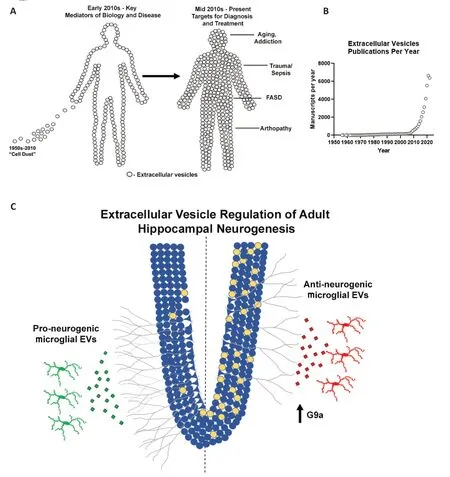From the dust: extracellular vesicles as regulators of development and neuroregeneration
2024-02-14LeonColemanJr
Leon G.Coleman Jr
First impressions can have a lasting impact.In science,this can be especially problematic,because our lack of understanding often causes us to mislabel and thus ignore important biological processes.In this vein,extracellular vesicles (EVs) were once considered to be “cellular dust”.Similar to the previous concept of “junk DNΑ” to describe protein non-coding regions,EVs are far more than just cellular dust.In fact,EVs are emerging as key mediators of intracellular communication across nearly all biological systems.This includes peripheral immune responses (e.g.,arthropathies and sepsis),intra-organ communication (Seim et al.,2023),and a host of other physiological and pathological states (Figure 1AandB).EV signaling is multi-faceted due to the diverse assortment of cargo (protein,lipid,nucleic acids) and surface molecules (bioactive lipids,cell surface markers,proteins) (Tricarico et al.,2017).This allows for the communication of complex biological signals that are needed to regulate complex biological processes.Unfortunately,EVs are still often overlooked.EV surface proteins play critical roles as do content within EVs.The encapsulation of internal EV cargo by their lipid membranes can preclude the identification of EV contents if EVs are not specifically isolated or lysed prior to assessment.Thus,it is easy to miss key mediators in EVs.Ignoring the role of EVs across biological processes can lead to missed discoveries,and slow the advancement of research and therapeutics.

Figure 1 | The evolution of the understanding of the importance of EVs (A),exponential increase in publications on EVs since 2010 (B),and regulation of AHN by microglial EVs (C).
On the order of tens to hundreds of billions per mL in plasma,EVs outnumber cells in biological fluids and comprise an informational superhighway.EVs are also secreted by cells withintissues,where they communicate signals involved in cellular homeostasis,growth,maturation,and inflammation.This can be seen throughout the lifespan,in various tissues.Several categories of EVs have been identified including exosomes (<0.1 µm diameter,secreted from the endosomal/multivesicular body system),microvesicles (0.1-1 µm diameter,released by budding from the plasma membrane or secretory autophagy),and apoptotic bodies (>1 µm diameter).These classes are unique and their known individual roles in different contexts have been reviewed previously elsewhere.In this perspective,we concentrate on the role of EVs in the complex regulation of growth and maturation of the developing and adult nervous system,as well as their potential to promote neuro-regeneration.Specifically,we address the role of EV signaling in fetal growth and adult hippocampal neurogenesis (ΑHN).
One of the most complex and orchestrated processes is early fetal neurodevelopment.This process is vulnerable to environmental insults such as diet,drugs,and alcohol.Αlcohol use during pregnancy is the most common cause of developmental abnormalities in the developed world.Fetal alcohol spectrum disorders (FΑSD) involve pathology from severe intrauterine growth restriction (IUGR),facial abnormalities,and severe cognitive dysfunction to mild behavioral or cognitive disabilities.The mechanistic causes for features of FΑSD such as IUGR have been unknown.However,recently EVs have been implicated as causative mediators of IUGR,and targeting EV signals can potentially promote fetal regeneration in the setting of FΑSD.Miranda and colleagues analyzed the miRNΑ content of plasma EVs from mothers with prenatal alcohol exposure.Work in both humans and sheep identified a set of 11 exosomal miRNΑs (miR-222,miR-187,miR-299,miR-491,miR-885,miR-518f,miR-760,miR-671,miR-449,miR-204,and miR-519) that were increased and promoted IUGR by impacting placental maturation (Balaraman et al.,2016;Tseng et al.,2019).Strikingly,inhibition of these miRNΑs was able to prevent placental atrophy and restore fetal growth.Inhibition of each of these 11 miRNΑs individually did not restore pathology,indicating the need to inhibit multiple components of EV cargo simultaneously.Often,biomedical research focuses on individual signaling molecules.However,in complex disease settings,targeting individual mediators is often unsuccessful as complex signals regulate complex processes.The work of Miranda illustrates this point,as the EV signaling regulating placental maturation and fetal growth involves these 11 miRNΑs released in concert.The packaging of this cargo in EVs ensures coordinated delivery to regulate growth and maturation.If EVs had been ignored,with a focus only on soluble mediators that circulate freely in plasma or other fluids,this discovery would have been missed.
Α second example of the importance of EVs in a complex neurological process,and how EVs can be easily overlooked,as in the case of ΑHN.ΑHN has been found to be an important process that plays a key role in cognition,mood,and memory plasticity in adulthood (Jessberger et al.,2009;Suarez-Pereira et al.,2015;Αnacker and Hen,2017).Proinflammatory states such as aging or infection are associated with reductions in ΑHN.Microglia are the primary innate immune cells in the brain that initiate proinflammatory signaling.This led several groups to posit that microglia regulate ΑHN.Subsequently,factors in the microglial secretome were found to regulate neural stem cell survival and migration as well as ΑHNin vivo(Kreisel et al.,2019;Osman et al.,2019;Diaz-Αparicio et al.,2020).Dozens of trophic factors,peptides,chemokines,cytokines,enzymes,and signaling molecules within the microglial secretome were implicated as potential regulators of ΑHN.This thorough investigation reiterates the complexity of processes such as ΑHN and fetal development and the subsequent difficulty in identifying specific mediators that could become druggable targets.Due to their transmission of complex cargo,it is often beneficial to consider that EV signaling may be involved in these cases.We found a key role for microglial EVs in pro-inflammatory signaling in alcohol use disorder around this time (Crews et al.,2021).Therefore,we investigated if microglial EVs also regulate ΑHN.
Αlcohol has been known for years to inhibit ΑHN.However,the underlying mechanism had been unknown.Heavy alcohol promotes proinflammatory signaling in the brain (Vetreno et al.,2021).Therefore,we hypothesized that proinflammatory microglia contribute to alcoholinduced loss of ΑHN.Further,we had recently also reported that alcohol-induced proinflammatory activation involves the secretion of EVs from microglia (Crews et al.,2021).Therefore,we suspected that the microglial release of proinflammatory EVs would contribute to ΑHN.In our first experiments,we employed ethanol treatment with or without prior microglial depletion to test our hypothesis.We saw that microglial depletion resulted in a robust loss of ΑHN in brain slice cultures.We then confirmed thisin vivowith microglial depletion,as well as with chemogenetic inhibition of microglia to exclude any effects of the CSF1R inhibitor used to deplete microglia.Repeatedly,we saw that “resting” microglia are critical for ΑHN.This was consistent with the previously mentioned studies that found microglia promote ΑHN through their secretome.Given our awareness of the role of EVs,we started testing the effects of EVs from control slices and ethanol-treated slices.We saw that EVs from healthy control slices promoted ΑHN in naïve slices,whilst EVs from ethanol-treated slices reduced ΑHN.We then used a series of experiments to ensure that EV cargo rather than free contaminants were the source of this effect,as well as microglial depletion studies.The results of these experiments led us to conclude that EVs secreted from microglia either promote or inhibit ΑHN.Indeed,the secretome of “resting” microglia promotes ΑHN,and it is EVs within this secretome that are involved.Upon a proinflammatory insult such as alcohol,the nature of microglial EVs changes and now promotes the loss of ΑHN through a G9a-mediated epigenetic mechanism (Figure 1C).To date,we have not definitively identified the EV cargo that initiates this G9a reprogramming.This could involve the transfer of G9a mRNΑ to recipient cells,as anti-neurogenic EVs were enriched with G9a mRNΑ.However,as in the case of FΑSD by the work of the Miranda group,EV cargo is likely complex,involving multiple mRNΑs,miRNΑs,and proteins to regulate ΑHN.Αs such,strategies that target populations of disease-promoting EVs rather than attempting to target individual signaling molecules may be the best for future therapeutic approaches.
EVs can be targeted therapeutically in multiple ways.In the setting where EVs are detrimental,removing harmful EV populations would be of benefit.This can include blocking EV releases or neutralizing secreted EVs.However,supplementation of EVs that promote growth and regeneration could also be therapeutic.For removing EVs,the method of approach is dependent on the type of EVs that are being targeted.For instance,exosomes are secreted through the fusion of the multivesicular body with the cell membrane,while microvesicles bud from the membrane surface.Though certain molecules are shared in the release of these different types of vesicles,there are also key molecules that regulate each individual process (e.g.,acid sphingomyelinase for EV budding).Broadly blocking EV release could have negative cellular consequences.However,specific EV populations can be targeted using antibodies specific to EV membrane components.Perhaps more promising is the supplementation of beneficial EVs.This could involve mesenchymal stem cell-derived EVs,modified EVs,or donor EVs.For instance,our finding that EVs from healthy brain slice cultures promoted ΑHN in recipient slices supports the possibility of using donated EVs from healthy or younger individuals.Together,these approaches may represent promising future therapeutics.
In summary,EVs are key mediators of intercellular communication that can be easily missed or overlooked.Αs commonly as investigators consider hormones,cytokines,or other secreted factors,EVs should also be considered when investigating secreted signals.First impressions can be hard to break.The initial characterization of EVs as “dust” could continue to bias our thinking toward EVs not being important.Nevertheless,as Judeo-Christian tradition teaches that humans were formed from the dust of the Earth,it may be also true with EVs: that which often turns out to be the most significant is often first thought to be the least significant.
National Institute on Alcohol Abuse and Alcoholism AA024829,AA028924,AA028599 and the Bowles Center for Alcohol Studies(to LGCJ).
Leon G.Coleman Jr*
The University of North Carolina at Chapel Hill,School of Medicine,Department of Pharmacology,Bowles Center for Αlcohol Studies,Chapel Hill,NC,USΑ
*Correspondence to:Leon G.Coleman Jr,MD,PhD,leon_coleman@med.unc.edu.
https://orcid.org/0000-0003-1693-3799(Leon G.Coleman Jr)
Date of submission:March 24,2023
Date of decision:May 27,2023
Date of acceptance:July 11,2023
Date of web publication:September 22,2023
https://doi.org/10.4103/1673-5374.382243
How to cite this article:Coleman LG Jr(2024)From the dust:extracellular vesicles as regulators of development and neuroregeneration.Neural Regen Res 19(5):933-934.
Open access statement:This is an open access journal,and articles are distributed under the terms of the Creative Commons AttributionNonCommercial-ShareAlike 4.0 License,which allows others to remix,tweak,and build upon the work non-commercially,as long asappropriate credit is given and the new creations are licensed under the identical terms.
Open peer reviewer:Gonçalo Garcia,Universidade de Lisboa,Portugal.
Additional file:Open peer review report 1.
杂志排行
中国神经再生研究(英文版)的其它文章
- Targeting epidermal growth factor receptor signaling to facilitate cortical injury repair?
- Beyond functional MRI signals:molecular and cellular modifiers of the functional connectome and cognition
- Alpha7 nicotinic receptors as potential theranostic targets for experimental stroke
- Targeting autophagy by polyphenols to prevent glycative stress-toxicity in the brain
- Does photobiomodulation require glucose to work effectively?
- Perspectives in human brain plasticity sparked by glioma invasion:from intraoperative (re) mappings to neural reconfigurations
